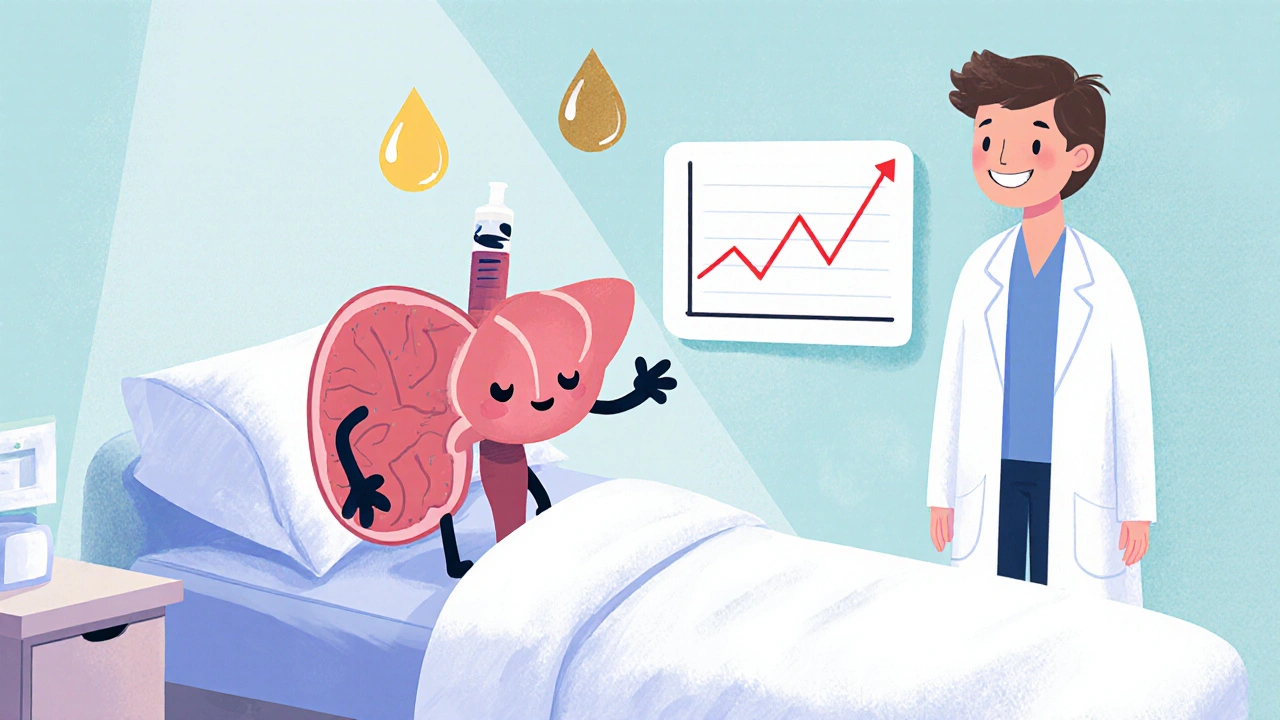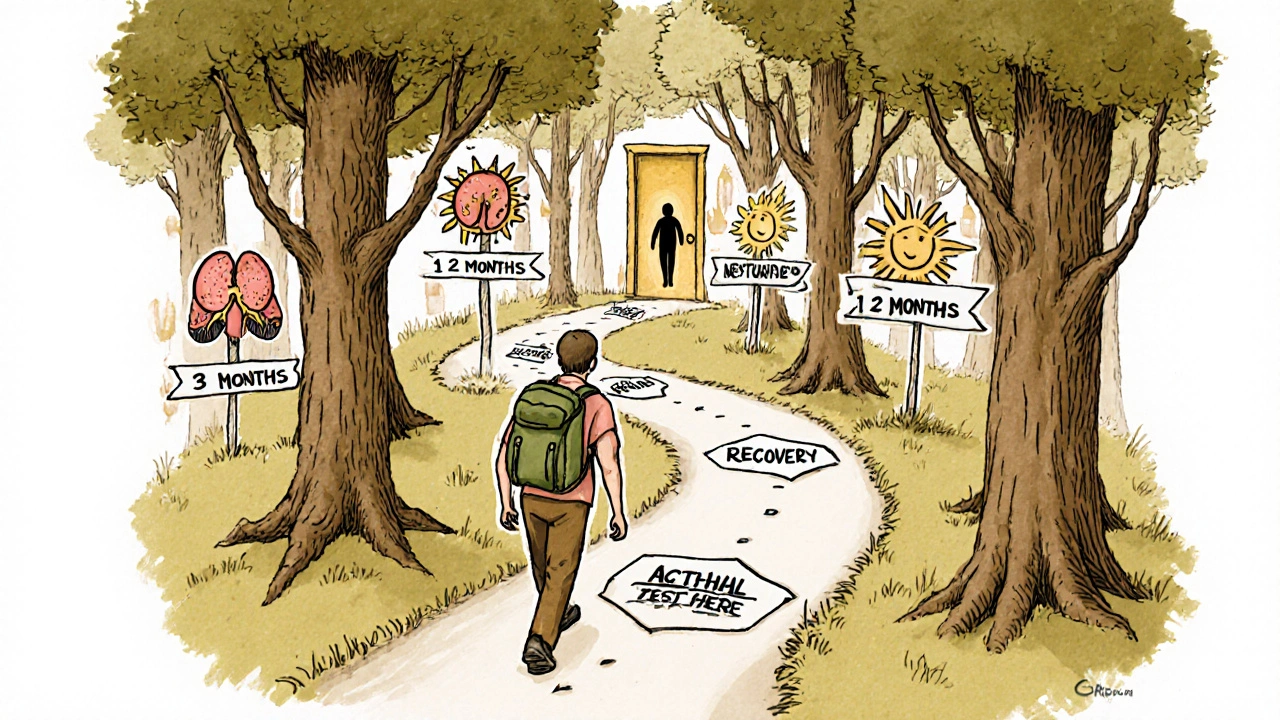Adrenal Recovery Calculator
This calculator helps determine if your adrenal glands are ready to resume natural cortisol production after long-term steroid therapy. Enter your ACTH stimulation test results to see if you've achieved sufficient adrenal recovery.
Stopping long-term steroid use isn’t as simple as just cutting the pill in half and waiting. When you’ve been on steroids like prednisone for months or years, your body stops making its own cortisol. If you quit too fast, your adrenal glands can’t snap back in time - and that can lead to a life-threatening drop in blood pressure, extreme fatigue, vomiting, or even shock. This is where ACTH stimulation testing comes in. It’s not a routine blood test. It’s a controlled, clinical tool used to see if your adrenal glands are ready to start working again after years of being turned off by medication.
Why Your Body Needs Help Restarting Cortisol Production
Your body makes cortisol naturally through a chain of signals: your brain tells your pituitary gland to release ACTH, which then tells your adrenal glands to produce cortisol. This hormone manages stress, blood sugar, immune response, and blood pressure. When you take steroid pills for more than 3-4 weeks, your body says, “We don’t need to make our own anymore,” and shuts down the whole system. It’s like turning off a faucet and forgetting how to turn it back on. The problem? When you stop steroids suddenly, your adrenal glands are still asleep. They’ve shrunk a bit from disuse. Without cortisol, your body can’t handle even minor stress - a cold, a dental visit, or a car accident. Studies show that without a proper taper and testing, up to 8.5% of people on long-term steroids suffer an adrenal crisis. With structured protocols using ACTH tests, that number drops to just 1.2%.What Is an ACTH Stimulation Test?
The ACTH stimulation test (also called the cosyntropin test) is the gold standard for checking adrenal recovery. Here’s how it works:- A synthetic form of ACTH (called cosyntropin) is injected into your vein or muscle - usually 250 micrograms.
- Your blood is drawn before the injection, then again at 30 and 60 minutes after.
- Doctors measure how much cortisol your adrenals produce in response.
How Long Should You Taper?
There’s no one-size-fits-all schedule. Tapering depends on how long you’ve been on steroids and why you started them. But here’s what the experts agree on:- 3-12 months of use: Reduce your dose by 2.5-5 mg of prednisone every 1-2 weeks until you hit 10-15 mg/day. Then slow down to 20-25% reductions per week. This is the PJ Nicholoff Protocol, widely used in neuromuscular conditions like Duchenne muscular dystrophy.
- Over 12 months of use: Recovery takes about one month for every month you were on steroids. So if you took steroids for 18 months, expect 12-18 months of tapering. Some people need even longer.

When Should You Get the ACTH Test?
Timing is everything. You don’t test too early. You don’t test too late. The 2024 Endocrine Society guideline says: test when you’ve reached a physiologic replacement dose - around 4-6 mg of prednisone daily - and before you stop completely. Some protocols, like the one from the Adrenal Insufficiency Coalition, recommend testing everyone after 3 months of therapy. Others, including the Endocrine Society, say only test if you’re symptomatic or at high risk. But data shows that relying only on symptoms is dangerous. About 35-45% of people going through steroid withdrawal feel awful - fatigue, nausea, joint pain - but that doesn’t always mean their adrenals are still suppressed. That’s called glucocorticoid withdrawal syndrome. It’s not adrenal insufficiency. It’s your body adjusting. The ACTH test helps you tell the difference.What Happens If the Test Shows You’re Not Ready?
If your cortisol stays low, you don’t panic. You don’t restart high doses. You go back to your last tolerated dose - the one you were on before you started feeling bad - and stay there for 4-6 weeks. Then try tapering again, slower this time. Re-test at the same low dose. Some patients need to stay on low-dose steroids for months, even years. That’s not failure. It’s biology. Permanent adrenal insufficiency happens in about 10-20% of people who’ve been on high-dose steroids for more than a year. That’s not rare. It’s expected. And if it happens, you’ll need lifelong replacement therapy - usually hydrocortisone taken three times a day (10 mg in the morning, 5 mg at noon, 5 mg in the afternoon) to mimic your body’s natural rhythm.Real-World Challenges: Access, Anxiety, and Gaps in Care
The science is clear. The guidelines are solid. But the real world? It’s messy. In rural areas, patients may have to drive 3+ hours to get an ACTH test. One primary care doctor on Reddit said, “I send them to the city. Half never show up. Then they get sick and come to me in crisis.” Patients report intense anxiety during tapers. A 2023 survey by Adrenal Insufficiency United found that 78% felt constant worry about stopping, and 42% had severe withdrawal symptoms - even when following the plan. And then there’s the testing delay. In 61% of cases, patients wait over four weeks for an appointment. Some end up in emergency rooms because they couldn’t get tested in time.
What You Need to Do Right Now
If you’re on long-term steroids and planning to stop:- Don’t quit cold turkey. Ever.
- Ask your doctor about an ACTH stimulation test - don’t wait for symptoms.
- Know your current dose in prednisone equivalents. Hydrocortisone? Methylprednisolone? Make sure you understand the conversion.
- Carry a steroid alert card. All guidelines say this. Only 47% of community patients do.
- Know your stress dose rules. If you get sick, injured, or have surgery, you need more steroids - not less. Your body can’t make extra cortisol. You have to give it to yourself.
The Future: Faster Tests, Better Tools
The field is changing. The NIH just funded a $4.2 million project to build a point-of-care ACTH test - something you could get done in a doctor’s office in under an hour, not weeks later. Epic’s EHR system is adding HPA axis tracking modules in 2025. And a mobile app from the Endocrine Society is coming late 2024 to help patients and doctors track taper progress. The biggest research gap? Finding a simple blood or saliva marker that predicts adrenal recovery without needing the ACTH test. Salivary cortisol is being studied - it’s less invasive, and you can test it multiple times a day. But it’s not ready yet.Bottom Line
Long-term steroid use isn’t a quick fix. Stopping it safely isn’t about willpower. It’s about biology. ACTH stimulation testing isn’t optional - it’s the only reliable way to know if your adrenals are awake. Skip the test, and you risk your life. Follow the protocol, and you give your body the time and data it needs to heal.It’s not about being afraid of steroids. It’s about respecting how deeply they change your body - and giving it the chance to recover.
Can I stop steroids on my own if I feel fine?
No. Feeling fine doesn’t mean your adrenal glands are working. Steroid suppression is silent. You can feel great and still have zero cortisol production. Stopping abruptly can cause sudden adrenal crisis - even if you’ve been on steroids for just 3 weeks. Always follow a doctor-supervised taper with ACTH testing.
How long does it take for adrenal glands to recover after stopping steroids?
It varies. For 3-12 months of steroid use, recovery can take 6-12 months. For over a year of use, it can take 9-18 months or longer. Some people never fully recover and need lifelong low-dose replacement. The key is testing - not guessing. Your body’s timeline is unique.
Is the ACTH test painful or risky?
It’s a simple injection, similar to a flu shot. Some people feel a brief sting or flushing, but serious reactions are rare. The test is safe when done under medical supervision. The real risk is skipping it - not having it.
What if I can’t get an ACTH test because of long wait times?
If testing is delayed, don’t rush your taper. Stay at your current dose until you can get tested. If you develop symptoms like dizziness, nausea, or weakness, contact your doctor immediately - you may need a temporary dose increase or emergency steroid injection. Never wait until you collapse.
Do I need to carry a steroid alert card?
Yes. If you’ve been on steroids for more than 3 weeks, you should carry a medical alert card or bracelet stating you’re at risk for adrenal insufficiency. In an emergency, paramedics and ER staff need to know you need immediate steroid treatment - even if you’re not conscious. Only about half of patients do this, but it can save your life.
Can I use over-the-counter supplements to help adrenal recovery?
No. Supplements like licorice root, ashwagandha, or adrenal support blends have no proven effect on restoring HPA axis function. In fact, some can interfere with cortisol testing or mask symptoms. The only proven treatment is medically supervised tapering and ACTH testing. Don’t replace science with trends.


Comments
Paula Jane Butterfield
Just went through a 14-month taper after 3 years on prednisone for lupus. ACTH test was a game-changer. My endo didn’t even mention it until I asked. Don’t let them rush you. Your body isn’t a light switch.
My first test showed cortisol at 8.2. I cried. Second test, 19.1. I hugged my dog. Third test, 22.5. I ate a whole pizza. No regrets.
If you’re on long-term steroids, demand this test. It’s not optional. It’s survival.
November 21, 2025 at 14:13
Simone Wood
ACTH stimulation? That’s just fancy doctor talk for ‘we’re gonna poke you with a needle and see if your adrenal glands still remember how to work.’
My doc called it ‘the cortisol wake-up call.’ Honestly? Feels like they’re testing if your body’s still alive after years of being medicated into a coma.
November 21, 2025 at 21:18
Florian Moser
This is exactly why patient education matters. Most people think stopping steroids is just ‘cutting the dose’-but it’s more like retraining a muscle that forgot how to flex.
The 8.5% vs 1.2% stat? That’s not just numbers. That’s someone’s life. If you’re on long-term steroids, find a doctor who knows this protocol. Don’t settle for guesswork.
November 23, 2025 at 05:12
jim cerqua
They’re not just testing your adrenals-they’re testing your will to live.
I watched my cousin go from ‘I’m fine’ to ‘I can’t stand up’ in 36 hours because they skipped the ACTH test. They called it ‘an unfortunate complication.’ I call it medical negligence.
And now? They want to make this test ‘optional’ because ‘it’s expensive.’ Like your life is a budget line item.
November 24, 2025 at 07:17
Donald Frantz
Why isn’t this standard protocol everywhere? Why are patients still being told to ‘just taper slower’ without objective data?
The fact that this test reduces adrenal crisis from 8.5% to 1.2% should be front-page news. Instead, it’s buried in endocrinology journals while people die waiting for their cortisol to wake up.
November 25, 2025 at 04:28
Sammy Williams
My doc did this test on me after 2 years on prednisone. I thought I was fine-I wasn’t even tired anymore. But the test showed I was still basically a zombie with a heartbeat.
Turns out I needed another 3 months to fully recover. Thank god they didn’t let me quit cold turkey. I’m not a fan of needles, but I’ll take a shot for my adrenal glands any day.
November 25, 2025 at 15:19
Debanjan Banerjee
In India, most patients don’t even know ACTH testing exists. Doctors assume tapering is enough. I’ve seen patients collapse in outpatient clinics because they were discharged too early.
This isn’t just Western medicine-it’s basic physiology. If your HPA axis is suppressed, you need functional assessment, not guesswork. The data is clear. The system isn’t.
Advocate for yourself. If your doctor doesn’t mention ACTH, ask for it. Politely. But insist.
November 26, 2025 at 03:35
Steve Harris
It’s wild how something so simple-injecting a synthetic hormone and measuring a hormone response-can be the difference between life and death.
I’ve had patients who thought they were ‘fine’ after 6 months of tapering. Then they got a cold, passed out, and ended up in ICU. ACTH testing isn’t a luxury. It’s the baseline.
And honestly? It’s not even that expensive. Why aren’t we doing this for everyone?
November 27, 2025 at 01:02
Michael Marrale
Ever wonder why Big Pharma doesn’t push this test? Because if you know your adrenals are recovering, you don’t need to stay on meds forever. And if you don’t need meds, you don’t need prescriptions.
They’d rather keep you dependent. The ACTH test? It’s a threat to the system.
They’ll tell you it’s ‘not necessary.’ They’re lying. Your body remembers what they want you to forget.
November 27, 2025 at 18:12
David Cusack
One must, of course, acknowledge the profound epistemological implications of ACTH stimulation testing-not merely as a diagnostic tool, but as a metaphysical interrogation of the body’s autonomy under pharmacological domination. The adrenal cortex, in its silent rebellion, becomes a site of ontological resistance.
And yet-how many patients, bereft of access, are left to suffer the silent collapse of their endocrine dignity?
November 28, 2025 at 20:20
Elaina Cronin
I have been in the ICU twice because of adrenal crisis. Both times, I was told I was ‘fine’ to stop steroids. Both times, I nearly died.
ACTH testing saved my life the third time. I am not exaggerating. If you are on long-term steroids, this is not a suggestion. It is your right. Fight for it. Demand it. Do not let them dismiss you.
I am not angry. I am terrified. And I will not let anyone else go through this.
November 29, 2025 at 23:13
Willie Doherty
The literature is unequivocal: ACTH stimulation testing demonstrates statistically significant improvement in adrenal recovery outcomes. The p-value is <0.001. The effect size is large. The clinical recommendation is Class I.
Yet, implementation remains inconsistent. This is not a failure of science. It is a failure of systems. Resource allocation, provider education, and institutional inertia are the true barriers-not the test itself.
November 30, 2025 at 13:17
Logan Romine
So we’re telling people to wait months for their body to ‘wake up’... while the system profits off them being sick?
😂
At this point, I’m convinced cortisol is just the universe’s way of saying ‘you’ve been lazy for too long, here’s a panic attack to motivate you.’
December 2, 2025 at 07:25
Chris Vere
Back home in Nigeria, most people don’t even know what cortisol is. They just know they feel weak after stopping pills. Some think it’s ‘witchcraft.’ Others think it’s God’s punishment.
This post should be translated. Shared. Printed. Put in clinics. Not just for the rich.
Someone’s life depends on this knowledge reaching the right person.
December 2, 2025 at 14:03
Mark Kahn
Just wanted to say thank you for this. My sister almost died because they skipped the test. I didn’t know any of this until it was too late.
Now I’m telling everyone I know. If you’re on steroids for more than a few weeks, ask for the ACTH test. Don’t wait until you’re in the ER.
You’ve got this. And you deserve to be safe.
December 3, 2025 at 23:42
Write a comment